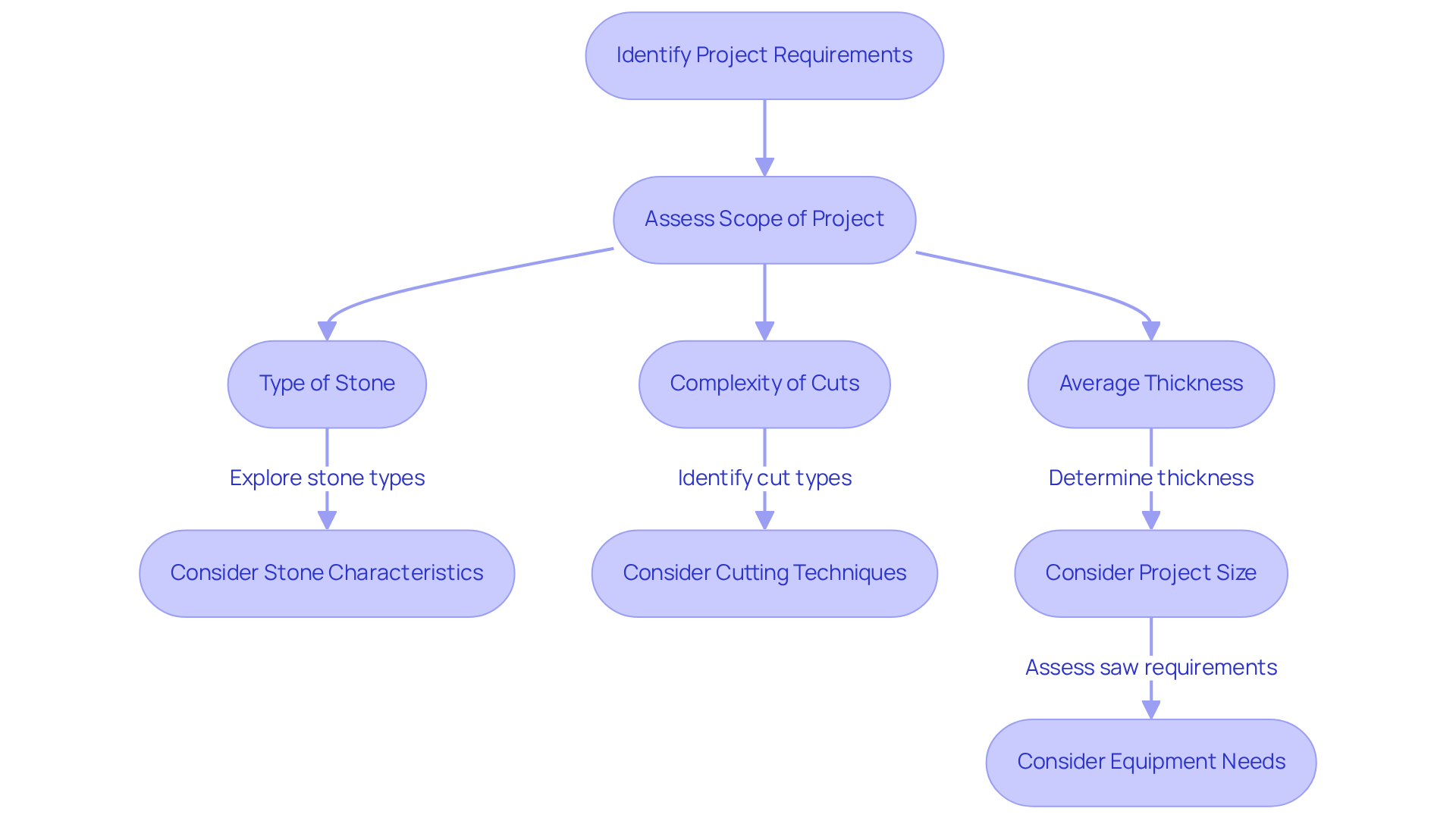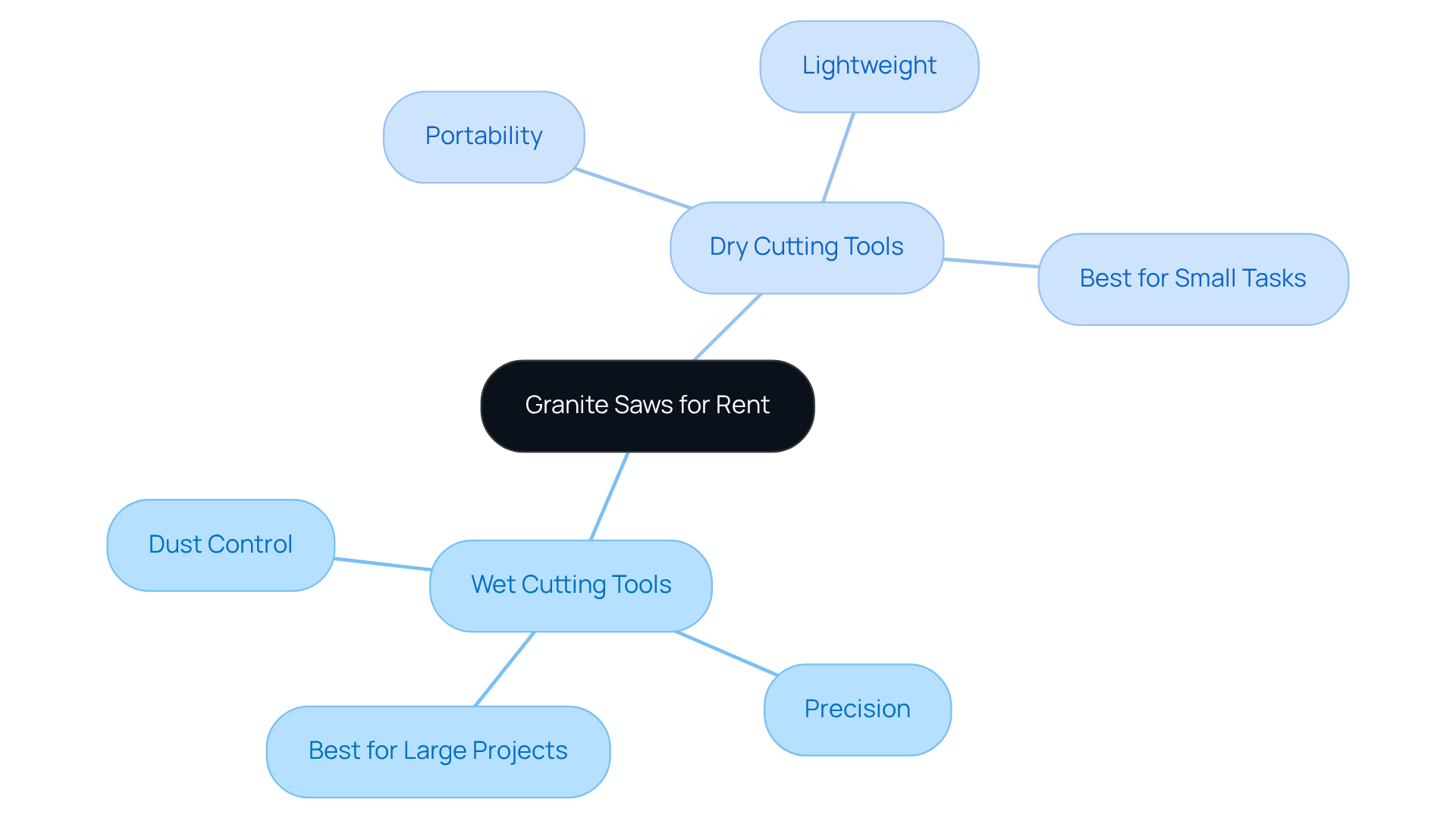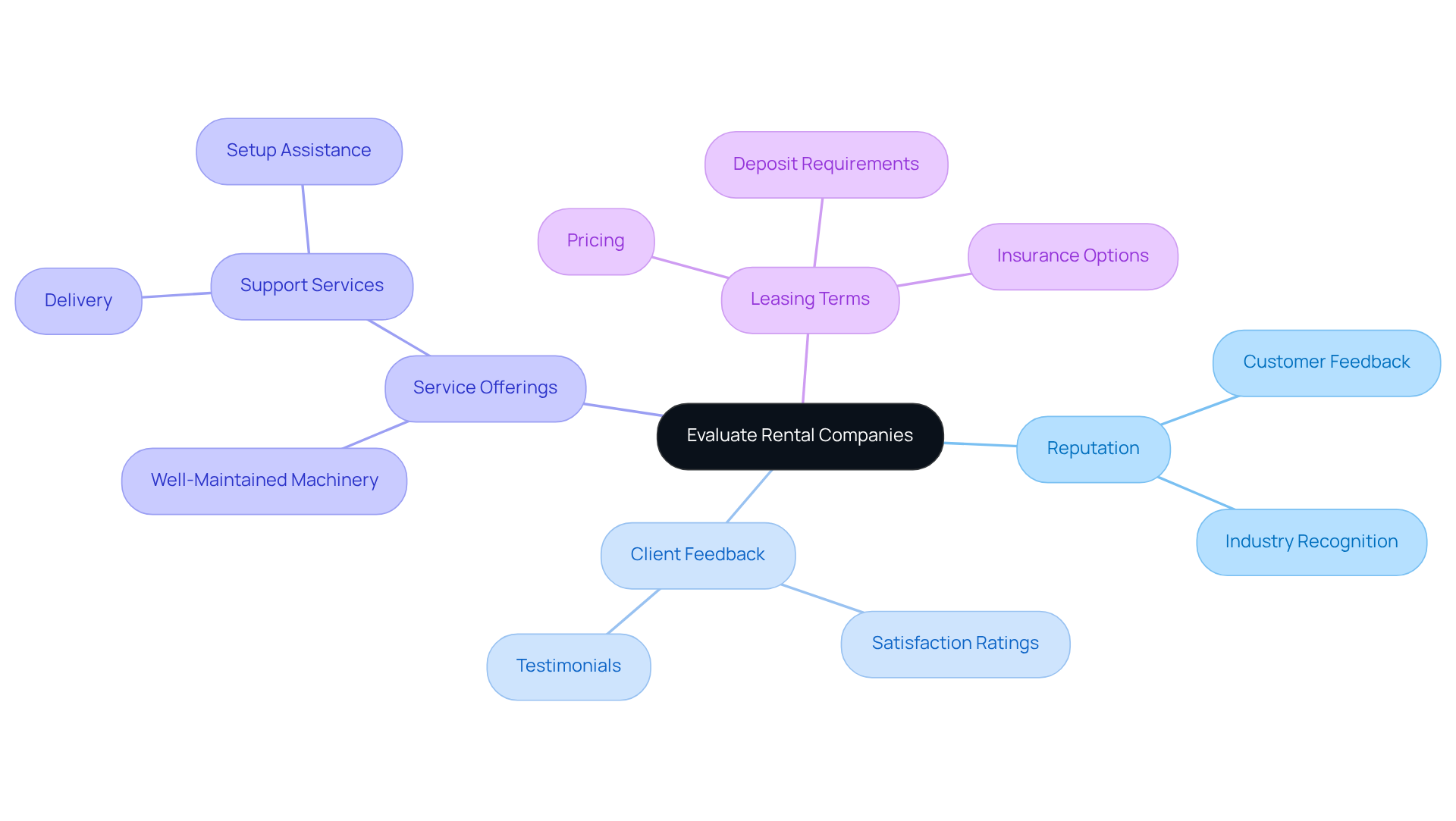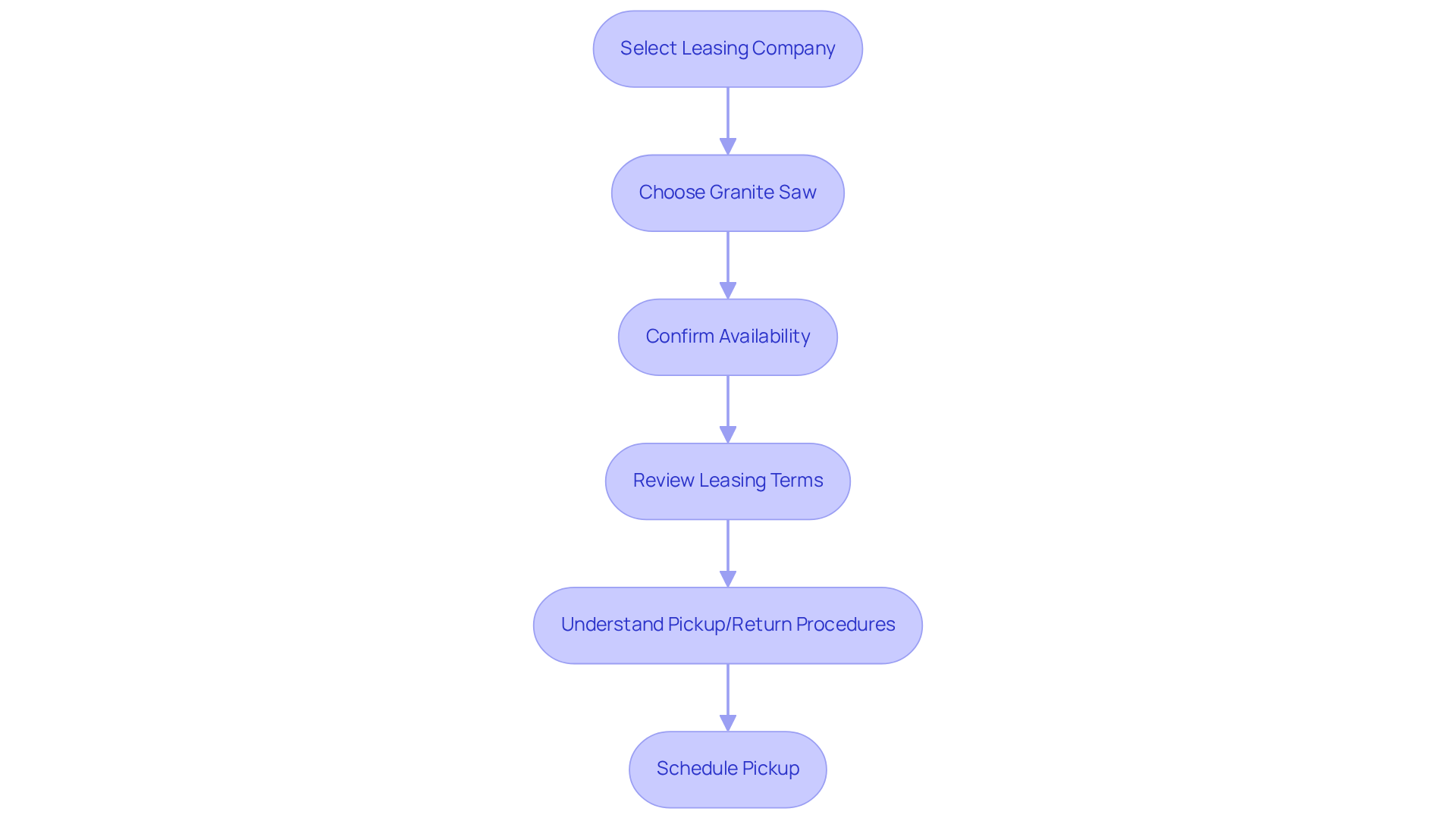Overview
To effectively secure your granite saw rental, begin by assessing your project requirements. Explore the various types of saws available and evaluate rental companies to identify the most suitable options. Finally, finalize your leasing agreement with confidence. This article outlines these essential steps in detail, emphasizing the importance of understanding your cutting needs and selecting the right tools based on project size and complexity. Additionally, choosing a reputable rental company is crucial to ensure a smooth and successful rental experience.
Key Highlights:
- Assess project requirements by understanding stone type, thickness, cut complexity, and quantity to guide saw selection.
- Consider wet cutting tools for larger projects needing precision and dust control, while dry cutting tools are suitable for smaller tasks.
- Evaluate saw dimensions and features like adjustable cutting depths to enhance performance.
- Research rental companies, focusing on reputation, customer feedback, and support services offered.
- Review leasing terms, including pricing, deposits, and insurance, to make informed rental decisions.
- Finalise the rental by confirming equipment availability, discussing project specifics, and understanding leasing agreements.
Introduction
Navigating the world of granite saw rentals can indeed present challenges, particularly given the rising demand for precision in stone cutting. It is crucial to grasp the nuances of various saw types alongside specific project requirements to achieve optimal results. With a plethora of options available, how can one confidently choose the right equipment and service provider? This guide delineates four essential steps to secure a granite saw rental effectively, empowering readers to make informed decisions that align with their project objectives.
- Research different types of granite saws available for rent.
- Assess specific project requirements to determine the suitable saw type.
- Compare rental service providers based on reviews and pricing.
- Make a final decision and arrange for the rental of the selected saw.
Identify Your Project Requirements
Begin by thoroughly assessing the scope of your project. Understanding the type of stone you will be cutting is crucial, along with the average thickness, which typically ranges from 2cm to 3cm for countertops and can extend up to 4cm for custom applications. It's essential to recognize that stone slabs may be as thin as 1 centimeter for lighter applications. Consider the complexity of the cuts required—whether you need straight cuts, intricate shapes, or bevels. Create a detailed list of specific tasks the saw will be used for, as this will guide your selection process.
Furthermore, evaluate the amount of stone you intend to cut; larger undertakings necessitate a more powerful saw with greater cutting capacity to ensure efficiency and accuracy. As one construction expert remarked, "Comprehending the scope of the undertaking is essential for identifying the appropriate equipment, as it directly affects both the quality of the work and the overall timeline." This comprehensive approach will assist you in making informed choices when renting a stone cutter, especially considering the rising popularity of this material in high-end projects.

Explore Types of Granite Saws for Rent
When considering granite saw rental options, it is essential to explore the various types available. Wet cutting tools stand out as a popular choice, utilizing water to cool the blade and minimize dust, making them particularly effective for slicing thicker granite. These tools are favored in larger construction projects where precision and cleanliness are paramount. In contrast, dry cutting tools offer enhanced portability and are frequently chosen for smaller, less complex tasks. Their lightweight design facilitates easier maneuverability, which can be advantageous in tight spaces.
The dimensions of the cutting tool are another critical element; larger instruments can handle bigger chunks of stone but may compromise some ease of maneuvering. Features such as adjustable cutting depths and specific blade types tailored to your cutting requirements can significantly enhance performance.
Statistics indicate that the demand for wet cutting tools is on the rise, driven by the increasing popularity of stone in both residential and commercial applications. The tile saw market is projected to exceed USD 1.3 billion by 2032, with a compound annual growth rate (CAGR) of 4.6% for the stand tile saw market from 2023 to 2029. Understanding the differences between wet and dry cutting tools is essential for making informed choices regarding granite saw rental.
In construction projects, the choice between wet and dry granite cutting tools often hinges on the specific needs of the task at hand, including the option for granite saw rental. For example, wet cutting tools are commonly employed in high-traffic areas where dust control is vital, while dry cutting devices may be utilized for quick cuts in less demanding environments. It is also crucial to consider the potential health hazards associated with silica-containing dust produced by stand tile saws. By carefully assessing these factors, you can select the most appropriate stone saw for your project.

Evaluate Rental Companies and Their Offerings
When selecting a leasing firm, evaluating their reputation and client feedback is essential, as these factors significantly influence the decision-making process. Businesses specializing in granite saw rental are often better equipped with well-maintained machinery tailored to specific requirements. It is advisable to confirm whether they offer support services, such as delivery and setup, which can enhance . Furthermore, understanding their leasing terms—including pricing, deposit requirements, and insurance options—is crucial for making informed decisions.
EZ Equipment Rental stands out in , recognized for its unwavering commitment to quality and customer satisfaction, making it a reliable choice for your granite saw rental needs. Customer feedback indicates that a strong reputation correlates with enhanced service and equipment reliability, which is vital in the competitive equipment leasing market. By choosing EZ Equipment Rental, you align yourself with a firm that prioritizes your needs and ensures a seamless leasing experience.

Finalize Your Granite Saw Rental
After selecting a leasing company and the right granite saw, the next step is to confirm availability and finalize your leasing agreement. Start by contacting the provider to discuss your project details and any specific requirements you may have. It is essential to thoroughly review the leasing terms, focusing on the duration, associated costs, and any potential additional fees. Understanding the pickup and return procedures, along with any maintenance or care instructions for the saw, is crucial for a successful rental experience.
EZ Equipment Rental operates Monday to Friday from 7:30 AM to 5:30 PM and Saturday from 7:30 AM to 5:00 PM, allowing you to plan your pickup accordingly. Once the paperwork is complete, schedule a pickup time that aligns with your project timeline to ensure a smooth workflow. With flexible rental terms and competitive pricing, EZ Equipment Rental stands out as a reliable choice for your needs regarding granite saw rental. This commitment to customer satisfaction is reflected in positive testimonials from satisfied clients who appreciate the quality and reliability of our equipment.

Conclusion
Understanding the process of securing a granite saw rental is essential for ensuring a successful stone cutting project. By carefully evaluating project requirements, exploring the types of granite saws available, assessing rental companies, and finalizing the rental agreement, individuals can make informed decisions that lead to efficient and high-quality outcomes.
Key insights from the article highlight the importance of identifying specific project needs, such as the type and thickness of the stone, as well as the complexity of cuts required. Additionally, the distinction between wet and dry cutting tools plays a crucial role in selecting the right equipment based on the project’s demands. Evaluating rental companies for their reputation and service offerings, like delivery and setup, further enhances the rental experience. Finally, a thorough review of rental terms ensures that all aspects of the agreement are understood, paving the way for a smooth rental process.
Ultimately, taking the time to follow these steps can significantly impact the quality and efficiency of granite cutting projects. Whether planning a small renovation or a large construction endeavor, proper preparation and informed choices will lead to better results and greater satisfaction. Embracing this structured approach not only saves time and resources but also elevates the overall quality of work, making it a vital consideration for anyone looking to rent a granite saw.
Frequently Asked Questions
What should I assess to identify my project requirements for cutting stone?
You should assess the scope of your project, including the type of stone, average thickness (typically 2cm to 3cm for countertops, up to 4cm for custom applications, and as thin as 1cm for lighter applications), and the complexity of the cuts required (straight cuts, intricate shapes, or bevels).
Why is it important to understand the thickness of the stone?
Understanding the thickness of the stone is crucial because it affects the type of saw you will need, as different thicknesses may require different cutting capacities and techniques.
How does the amount of stone I intend to cut influence my saw selection?
The amount of stone you plan to cut influences your saw selection because larger projects require a more powerful saw with greater cutting capacity to ensure efficiency and accuracy.
What is the significance of creating a detailed list of specific tasks for the saw?
Creating a detailed list of specific tasks helps guide your selection process by ensuring that the saw you choose is suitable for the particular cuts and applications you need for your project.
What impact does understanding the scope of the project have on equipment selection?
Understanding the scope of the project is essential for identifying the appropriate equipment, as it directly affects the quality of the work and the overall timeline of the project.




